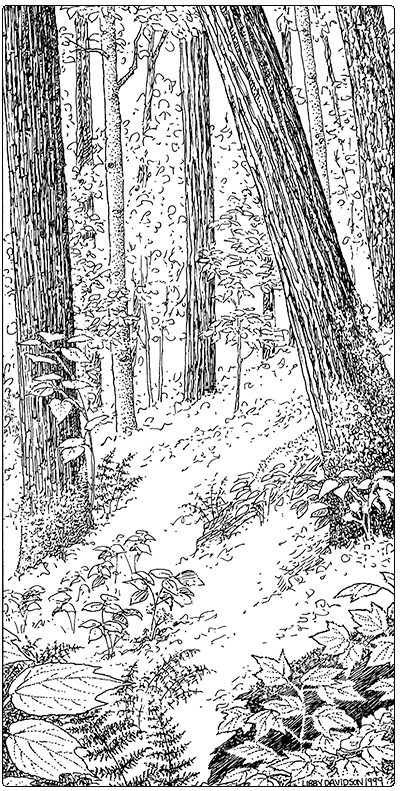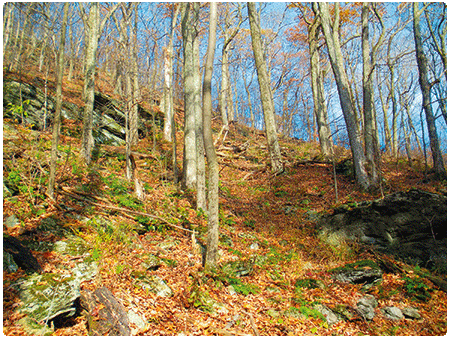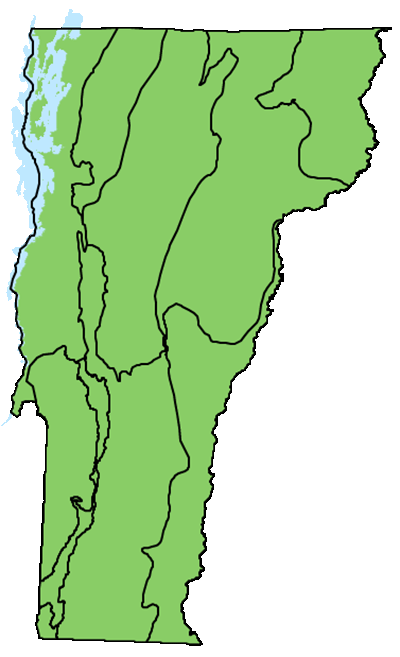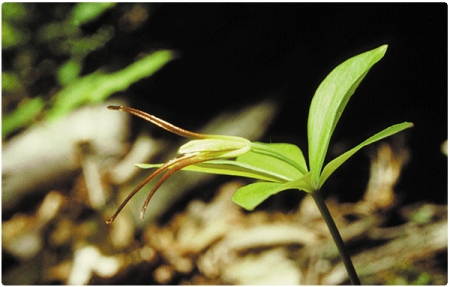Ecology and Physical Setting
These forests are similar to Northern Hardwood Forests but differ in having significant amounts of red oak in the canopy. They are essentially northern in character, which is evidenced by the lack of white oak and hickories. In the northern part of the red oak range this community occurs mostly on warm, dry microsites such as south-facing slopes. Soils are well drained to moderately well drained, and are derived from sands, gravels, or tills. Red Oak-Northern Hardwood Forests are found on warm slopes and terraces, generally below 2,500 feet and often facing south or west. Ecological processes include single tree fall and downslope movement of soil, nutrients, and seeds. Although these forests are generally mesic, they are more likely than Northern Hardwood Forests to experience droughty conditions. Red oak can persist in this community because of its drought tolerance and ability to germinate in relatively dry conditions. In contrast, sugar maple and other northern hardwoods are less drought-tolerant and need moist soil to germinate. Fire may play a role, too, but it is unlikely that these forests are maintained by regular fire. Productivity can be high due to the constant inflow
of nutrients from upslope.
Vegetation
Mid-successional trees include red oak, sugar maple, basswood, beech, and hemlock, with occasional butternut. The canopy is closed and trees are usually tall and straight. The shrub layer is sparse, with maple-leaved viburnum, beaked hazelnut, witch hazel, and shadbush as common components. Herbs are sparse, too, and include Christmas fern, marginal wood fern, intermediate wood fern, Indian cucumber root, and blue-stemmed goldenrod.
Wildlife Habitat
The abundance of red oak at these warm sites strongly influences wildlife habitat. With their high fat and calorie content, acorns are a nutritious food source for many wildlife species, including black bear, deer, turkeys, gray squirrels, and chipmunks. Wood ducks also rely on acorns for food and will feed in oaky forests near water. Wood thrush and eastern wood pewee are more abundant in these and other warm-climate forests than they are in Northern Hardwood Forests. Other common birds include red-eyed vireo, rose-breasted grosbeak, black-and-white warbler, and scarlet tanager. Gray foxes commonly locate their dens in hollow logs, tree cavities, or rock crevices on warm south or west-facing slopes—the same setting where Red Oak-Northern Hardwood Forests commonly occur. Unlike red foxes, gray foxes have semi-retractable claws that allow them to climb trees.
Successional Trends
 In addition to being a late-successional dominant, red oak can be an early successional species in this community. In harvested forests, stump sprouts from red oak can be abundant. Decades later, it may be possible to trace an old stump by its ring of mature oak stems—a view into the forest’s history. Other common trees in young Red Oak-Northern Hardwood Forests include bigtooth aspen and black cherry. In the southern two-thirds of Vermont, black birch can be common. White-tailed deer can hinder regeneration of red oak, because it is a favored browse species.
In addition to being a late-successional dominant, red oak can be an early successional species in this community. In harvested forests, stump sprouts from red oak can be abundant. Decades later, it may be possible to trace an old stump by its ring of mature oak stems—a view into the forest’s history. Other common trees in young Red Oak-Northern Hardwood Forests include bigtooth aspen and black cherry. In the southern two-thirds of Vermont, black birch can be common. White-tailed deer can hinder regeneration of red oak, because it is a favored browse species.
Late-successional Red Oak-Northern Hardwood Forests are impressive, with their tall, stately trees. Red oak persists in the canopy, along with sugar maple and beech.
Related Communities
- Northern Hardwood Forest is a closely related community, but has little to no red oak. Some early- to mid-successional Northern Hardwood Forests can have a significant red oak component. The canopy can mimic this natural community for a time, but species such as witch hazel and maple-leaf viburnum are usually absent.
- Dry Red Oak-White Pine Forest is also characterized by red oak, but is found on dry, shallow-to-bedrock ridges and slopes. Heath shrubs are usually dominant in the understory.
- Mesic Maple-Ash-Hickory-Oak Forest has sugar maple, beech, and red oak, but also has other oaks and hickories. It is typically found in warmer settings.
- Mesic Pine-Oak Sandplain Forest is also found on well-drained soils, but usually in warmer settings. Sugar maple is infrequent, and white pine is abundant.
Conservation Status and Management Considerations
There are no known examples of Red Oak-Northern Hardwood Forest that are free from human disturbance, though a few mature examples have been documented. With their relatively high productivity and presence of high-quality timber, these sites are vulnerable to the selective removal of oak. Foresters managing these sites should evaluate them to gain as much information as possible about natural successional trends, and work with these trends in developing silvicultural plans. An assessment of regeneration, and factors like deer browse that can affect it after a harvest, can help inform management planning. Care should be used in steep sites to avoid soil erosion.
Distribution/Abundance
This forest type is occasional in all biophysical regions at low to moderate elevations (below 1,500 feet in the north, below 2,500 feet in the south). Similar communities are found commonly in neighboring states to the south.
Characteristic Plants
Trees
Abundant Species
Red oak – Quercus rubra
Sugar maple – Acer saccharum
American beech – Fagus grandifolia
Occasional to Locally Abundant Species
White ash – Fraxinus americana
Basswood – Tilia americana
Butternut – Juglans cinerea
Eastern hemlock – Tsuga canadensis
Black birch – Betula lenta
Shrubs
Occasional to Locally Abundant Species
Maple-leaved viburnum – Viburnum acerifolium
Witch hazel – Hamamelis virginiana
Shadbushes – Amelanchier spp.
Striped maple – Acer pensylvanicum
Beaked hazelnut – Corylus cornuta
Low sweet blueberry – Vaccinium angustifolium
Herbs
Occasional to Locally Abundant Species
Indian cucumber root – Medeola virginiana
Intermediate wood fern – Dryopteris intermedia
Christmas fern – Polystichum acrostichoides
White wood aster – Eurybia divaricata
Blue-stemmed goldenrod – Solidago caesia
Blue cohosh – Caulophyllum thalictroides
Starflower – Lysimachia borealis
Wild oats – Uvularia sessilifolia
Canada mayflower – Maianthemum canadense
Sarsaparilla – Aralia nudicaulis
Bearded shorthusk – Brachyelytrum aristosum
Pointed-leaved tick-trefoil – Hylodesmum glutinosum
Hay-scented fern – Dennstaedtia punctilobula
Rare and Uncommon Plants

Red Oak-Northern Hardwood Forests.
Squawroot – Conopholis americana
American ginseng – Panax quinquefolius
Broad beech fern – Phegopteris hexagonoptera
Summer sedge – Carex aestivalis
Virginia spring beauty – Claytonia virginica
Flowering dogwood – Cornus florida
Large whorled pogonia – Isotria verticillata
Spotted wintergreen – Chimaphila maculata
Associated Animals
Southern flying squirrel – Glaucomys volans
Black bear – Ursus americanus
Gray fox – Urocyon cinereoargenteus
Wood thrush – Hylocichla mustelina
Hermit thrush – Catharus guttatus
Eastern wood pewee – Contopus virens
Rose-breasted grosbeak – Pheucticus ludovicianus
Ovenbird – Seiurus aurocapilla
Red-eyed vireo – Vireo olivaceus
Black-and-white warbler – Mniotilta varia
Black-throated blue warbler – Setophaga caerulescens
Scarlet tanager – Piranga olivacea
Hairy woodpecker – Picoides villosus
Pileated woodpecker – Dryocopus pileatus
Rare and Uncommon Animals
Northern long-eared bat – Myotis septentrionalis
Places to Visit
Pine Mountain Wildlife Management Area, Topsham, Vermont Fish and Wildlife Department
Proctor-Piper State Forest, Cavendish, Vermont Department of Forests, Parks, and Recreation
Merck Forest and Farmland Center, Rupert
